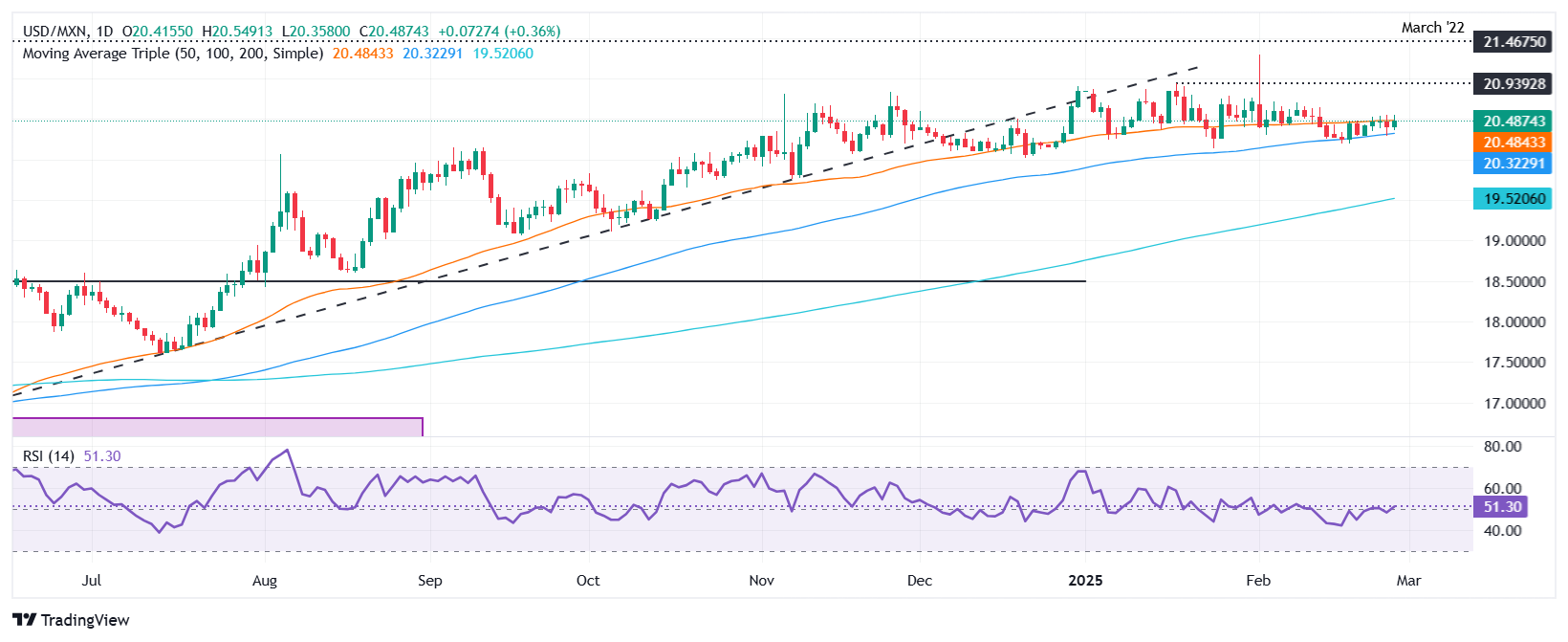Mexican Peso tumbles as Trump confirms Mexico tariffs for March
- Mexican Peso weakens 0.33% as trade tensions escalate despite negotiation efforts.
- USD/MXN jumped to 20.54 as Trump moves forward with delayed tariffs.
- Mexico’s Balance of Trade deficit widens and the unemployment rate rises.
- US GDP remains unchanged while weak jobs data fuels slowdown fears.
The Mexican Peso (MXN) depreciated against the US Dollar (USD) after United States (US) President Donald Trump revealed that delayed tariffs to be enacted in February would kick in on March 4 for Mexico and Canada. Therefore, the USD/MXN pair, after trading near 20.36, rose to a daily high of 20.54 before stabilizing at current levels. The exotic pair trades at 20.42, up 0.33%
Bloomberg News reported that tariffs imposed on Mexico are moving forward despite Mexican officials' efforts to strike a deal that could pause tariffs indefinitely, at least until the renegotiation of the USMCA free trade agreement in 2026. Consequently, Mexico’s Secretary of Economy, Marcelo Ebrard, returned to Washington to continue discussions.
Data-wise, Mexico’s Balance of Trade registered a larger-than-expected deficit and the Unemployment Rate rose. In the United States, data was mixed, with an upbeat Durable Goods Orders report. Gross Domestic Product (GDP) in its second estimate remained unchanged, hinting at an economic slowdown. Worse-than-expected US jobs figures paint a difficult outlook for the US economy.
Kansas City Federal Reserve (Fed) President Jeffrey Schmid said they need to balance growth concerns and inflation and warned that the Fed might need to address both.
Mexico’s economic docket will be empty this week, unlike the US. The release of the Federal Reserve’s (Fed) preferred inflation gauge, the Core Personal Consumption Expenditure (PCE) Price Index, is eyed, along with the Chicago PMI.
Daily digest market movers: Mexican Peso price action adrift to Trump’s tariffs rhetoric
- Mexico’s Balance of Trade deficit was more pronounced than the $-3.8 billion expected in January. It widened to $-4.55 billion after sustaining a surplus of $2.576 billion in December.
- The Unemployment Rate in Mexico rose by 2.7% as expected in January, up from December’s 2.4%.
- Washington is pushing the Mexican government to levy tariffs on Chinese imports.
- US Durable Goods Orders in January rose by 3.1% MoM following a -1.8% contraction in December, and crushed estimates of a 2% increase.
- The second estimate of GDP for the last quarter of 2024 was 2.3% QoQ, unchanged from estimates but below Q3’s 3.1% growth.
- On a bad note, Initial Jobless Claims for the week ending February 22 jumped to 242K, up from 220K revised, and exceeding projections of 221K.
- The swaps markets hint that the Federal Reserve might ease policy by 56.5 basis points, up from last week's 40 bps in 2025, via data from the Chicago Board of Trade (CBOT).
- Trade disputes between the US and Mexico remain prominent. Although the countries previously found common ground, USD/MXN traders should know that the 30-day pause is about to end, and tensions could trigger volatility in the pair during the rest of the week.
USD/MXN technical outlook: Mexican Peso drops as USD/MXN hurdles 50-day SMA
USD/MXN uptrend remains, though buyers remain unable to decisively crack the 50-day Simple Moving Average (SMA) at 20.45, which would open the door to testing 20.50. Momentum remains bullish, as depicted by the Relative Strength Index (RSI), which continues to aim higher, supported by Trump’s comments. Nevertheless, his rhetoric could trigger a swing and favor the Peso, which, as mentioned, remains heavily influenced by Trump.
Therefore, if USD/MXN pushes through 20.50, this could pave the way to challenge the January 17 high of 20.93, followed by 21.00 and the year-to-date (YTD) high of 21.28. On the flip side, if USD/MXN struggles at the 50-day SMA, it could drop to the 100-day SMA at 20.28, followed by the next support price level at 20.00.

Mexican Peso FAQs
The Mexican Peso (MXN) is the most traded currency among its Latin American peers. Its value is broadly determined by the performance of the Mexican economy, the country’s central bank’s policy, the amount of foreign investment in the country and even the levels of remittances sent by Mexicans who live abroad, particularly in the United States. Geopolitical trends can also move MXN: for example, the process of nearshoring – or the decision by some firms to relocate manufacturing capacity and supply chains closer to their home countries – is also seen as a catalyst for the Mexican currency as the country is considered a key manufacturing hub in the American continent. Another catalyst for MXN is Oil prices as Mexico is a key exporter of the commodity.
The main objective of Mexico’s central bank, also known as Banxico, is to maintain inflation at low and stable levels (at or close to its target of 3%, the midpoint in a tolerance band of between 2% and 4%). To this end, the bank sets an appropriate level of interest rates. When inflation is too high, Banxico will attempt to tame it by raising interest rates, making it more expensive for households and businesses to borrow money, thus cooling demand and the overall economy. Higher interest rates are generally positive for the Mexican Peso (MXN) as they lead to higher yields, making the country a more attractive place for investors. On the contrary, lower interest rates tend to weaken MXN.
Macroeconomic data releases are key to assess the state of the economy and can have an impact on the Mexican Peso (MXN) valuation. A strong Mexican economy, based on high economic growth, low unemployment and high confidence is good for MXN. Not only does it attract more foreign investment but it may encourage the Bank of Mexico (Banxico) to increase interest rates, particularly if this strength comes together with elevated inflation. However, if economic data is weak, MXN is likely to depreciate.
As an emerging-market currency, the Mexican Peso (MXN) tends to strive during risk-on periods, or when investors perceive that broader market risks are low and thus are eager to engage with investments that carry a higher risk. Conversely, MXN tends to weaken at times of market turbulence or economic uncertainty as investors tend to sell higher-risk assets and flee to the more-stable safe havens.
Forex News
Keep up with the financial markets, know what's happening and what is affecting the markets with our latest market updates. Analyze market movers, trends and build your trading strategies accordingly.























